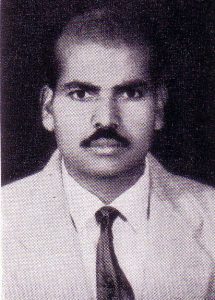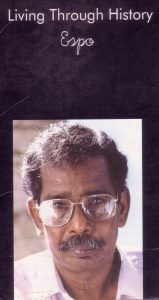Tamil linguistic scholar
by Sachi Sri Kantha, April 27, 2021

S. Thananjayarajasingham (circa 1966)
If there is one academic who had contributed to the understanding of linguistics of Jaffna Tamil, only one name can be stated with distinction. It is, Sabaratnasinghe Thananjayarajasingham! – Quite a mouthful. Due to this long, polysyllabic name (even by Tamil standards) with 21 English alphabets including 8 vowels, he was known among his pals with the suffix ‘Singhe’. For peculiar reasons, known only to his parents, his name combines two names – Thananjayan AND Rajasingham, into one. In introducing Prof. Vithiananthan’s 1968 review of ‘Tamil Studies in Ceylon’, in 2009, I had passingly mentioned about Singhe. Twelve years have passed since then.
A brief profile of Thananjayarajasingham, which appears in the Who’s Who booklet published for the First International Tamil Conference, indicates that he was born on January 1, 1933 at Vannarpannai, Ceylon. His earned degrees were B.A honors, University of Ceylon, April 1956; M.Litt., Annamalai University, Dec. 1961. He held the position of Lecturer in Tamil, University of Ceylon. An entry for Singhe, in Arumugam’s 1997 compilation more or less reproduced the above information, and nothing more. To mark the 55th anniversary, of the 1st International Tamil Conference held in Kuala Lumpur (April 16-23, 1966) under the direction of Father Thani Nayagam, I profile Singhe’s achievements as a Tamil scholar here. At this conference, he presented, not one but three research papers on usage of Tamil, related to the Dutch period of Ceylon.

Es.Po’s autobiography, vol.1 (2003)
Subsequently, Singhe earned a Ph.D. from the University of Edinburgh, for his dissertation, ‘The phonology of nominal forms in Jaffna Tamil’, in 1972. Sadly, he succumbed to a neurological disease (I vaguely remember, some virulent form of brain tumor) five years later in 1977, at the age of 44 years. This was indeed an irreparable loss to research on Tamil linguistics. In the past 44 years, those who have known him in person and flesh had failed to appraise Singhe’s scholarship. I did check the digitalized old issues of Mallihai monthly journal, edited by Dominic Jeeva from Jaffna, of 1977, for any bit of information about Singhe’s life. I couldn’t find any. Interestingly, Eelam’s foremost novelist Es. Po (aka, S. Ponnuthurai, 1932-2014) had written about Singhe in his two autobiographical volumes, Varalarril Vazhthal (Living through History) in 2003. Es. Po had reminisced,
“Among all those whom I have known, ‘Singhe’ was the one who bowled me with his memory power. During his final years, when I visited Colombo and failed to spend time with him, he would become upset. Sharing a drink with him, was a part of our Tamil heritage. One day, he invited me for a guest lecture at the Vidyalankara Universiy, Kelaniya. He was the head of Tamil department there. Two students who were from Kailasapathi’s camp raised a question, after reading two sentences from my novel ‘Sadanku’, and asked whether they are conventional to Tamil grammar. When I rose to answer their query, Thananjayarajasingham who presided that meeting interrupted immediately and delivered the verdict. ‘All the sentences that you had read from Sadanku novel have to be taken as good sentences following the conventions of Tamil grammar. If you ask, whether it is appropriate or so, you have to recognize it as ‘Es. Po’ tradition. Tradition is one established by intellectuals. Amongst us, Es. Po had attained that status.’ Later when I asked him about his verdict, he did say that not only for rebutting the charge of those students, but sincerely believed it. In those days, Colombo Tamil Sangam was engaged in compiling the Tamil words that had appeared in my novels, to prepare a dictionary for Eelam Tamil.
Subsequently, Singhe talked on the status of two (Tamil) epics Kundalakesi and Valaiyapathi. Now, both of these are considered as lost items. Singhe presented his thoughts that both epics originated as debating works during the religious war (between Hinduism and Buddhism), and their disappearance were indeed appropriate for historical reality.”
Again, Es. Po had informed that Singhe was so keen that he (Es.Po) should register for a M.A degree and continue the research for an earned Ph. D degree. But the untimely death of my friend turned out to be the final nail to the coffin for [my] wish for a M.A. degree.
Es. Po had been a well respected, incisive critic of skill-deficit, self-promoting figures who preened the Tamil literary world for half a century. Those who were leveled to half or quarter by Es. Po’s barbs include many heavy weights of Eelam land (including Prof. K. Kailasapathy, Prof. K. Sivathamby, Dr. A. Kandiah, Dominic Jeeva, C. Rajadurai, S.D. Sivanayagam). When a young Kannadasan (during his DMK phase of life) visited Ceylon in 1950s, Es. Po even took him to task for his contradictions. Thus, being posthumously appreciated for his intellect by Es. Po itself should be an award of merit to Singhe.
Apart from his specialty area of Jaffna Tamil language, Singhe also published on themes such as language records of Ceylon’s Dutch period, Arumuga Navalar and Telugu-speaking Gypsies in Batticaloa. Though Singhe’s life was cut short by disease, his research publications still attest to his unmatched talents. A bibliographical list of 28 publications, which I was able to collect, is given below. Three more additional references (with incomplete details) to Singhe’s early papers were provided in Vithiananthan’s 1968 review.
It is unfortunate that none that I know of had bothered to pick up the baton from Singhe, to enhance Eelam Tamil studies.
Bibliography
Thananjayarajasingham S. The language of some Tamil-Dutch documents of XVIIIth Century, M.Litt degree thesis, Annamalai University, 1961.
Thananjayarajasingham S. Some phonological features of the Jaffna dialect of Tamil University of Ceylon Review, 1962; 20(2): 292-302.
Thananjayarajasingham S. A phonological and morphological study of a Tamil plakaat. Tamil Culture, 1964; 11(2): 173-200.
Thananjayarajasingham S. A critical study of a Seventeenth century Tamil document relating to a commercial treaty, Hindu Student’s Union, University of Ceylon, Peradeniya, 1968, 96 pp.
Thananjayarajasingham S. The language of a Tamil plakkaat of the 18th century, In: Proc. of 1st International Conference Seminar of Tamil Studies, Kuala Lumpur, Malaysia, Apr. 1966, vol.2, eds. X.S. Thani Nayagam et al., Department of Indian Studies, University of Malaya, 1969, pp. 757-780.
Thananjayarajasingham S. A Tamil document relating to the Declaration and parole of the relatives of the last King of Kandy, In: Proc. of 1st International Conference Seminar of Tamil Studies, Kuala Lumpur, Malaysia, Apr. 1966, vol.2, eds. X.S. Thani Nayagam et al., Department of Indian Studies, University of Malaya, 1969, pp. 781-792.
Thananjayarajasingham S. Some Dutch loan-words in the Jaffna dialect of Tamil, In: Proc. of 1st International Conference Seminar of Tamil Studies, Kuala Lumpur, Malaysia, Apr. 1966, vol.2, eds. X.S. Thani Nayagam et al., Department of Indian Studies, University of Malaya, 1969, pp. 793-799.
Thananjayarajasingham S. A descriptive analysis of a Tamil document of the eighteenth century. In: Proc. of 2nd International Conference Seminar of Tamil Studies, Madras, India, Jan. 1968, ed. A. Subbiah, 1971, vol.1, pp. 378-383.
Thananjayarajasingham S. A Tamil Biljet relating to the obligatory services of certain subjects of the Dutch government in Ceylon. In: Proc. of 2nd International Conference Seminar of Tamil Studies, Madras, India, Jan. 1968, ed. R.A. Asher, 1971, vol.2, pp. 307-311.
Thananjayarajasingham S. A Tamil document relating to numismatic changes of the Dutch period in Ceylon. In: Proc. of 2nd International Conference Seminar of Tamil Studies, Madras, India, Jan. 1968, ed. R.A. Asher, 1971, vol.2, pp. 312-314.
Thananjayarajasingham S. The phonology of nominal forms in Jaffna Tamil University of Edinburgh, Ph.D dissertation, 1972.
Balasubramaniam T and Thananjayarajasingham S. Some observations on the plosives in colloquial Tamil as spoken in Jaffna (Ceylon). Indo-Iranian Journal, 1972; 14: 218-238.
Thananjayarajasingham S. Notes on the Telugu gypsies of Ceylon. Journal of Indian Anthropological Society, 1973; 8(2): 123-130.
Thananjayarajasingham S. Bilingualism and acculturation in the Kuravar community of Ceylon. Journal of Anthropological Linguistics, 1973; 15(6): 276-280.
Thananjayarajasingham S. The educational activities of Arumuga Navalar, Sri La Sri Arumuga Navalar Sabai, Colombo, 1974, 76 pp. (in Tamil)
Thananjayarajasingham S. Nominal compounds in Ceylon Tamil: a grammatical analysis. Acta Orientalia (Copenhagen), 1974; 36: 157-160.
Thananjayarajasingham S. Three Tamil proclamations issued under the Dutch rule in Ceylon. Acta Orientalia (Copenhagen), 1974; 36: 161-179.
Thananjayarajasingham S. Adjectival system in Jaffna Tamil – a prosodic analysis. Indian Linguistics (Pune), Mar 1974; 35: 131-143.
Thananjayarajasingham S. The plosives after nasals in Jaffna Tamil – Kymographic evidence on voicing. Indian Linguistics (Pune), Dec 1974; 35(4): 294-299.
Thananjayarajasingham S. The numerical system in Ceylon Tamil a grammatical study. Acta Orientalia (Copenhagen), 1975; 29(3): 381-384.
Thananjayarajasingham S. Aspiration in Jaffna Tamil. Linguistics, Apr 1975; 149: 59-63.
Thananjayarajasingham S. Nasalization in Jaffna Tamil. Linguistics, Apr 1975; 149: 65-73.
Thananjayarajasingham S. The numeral system in Sri Lanka Tamil: a grammatical study. Journal of Tamil Studies (Madras), June 1975; 7: 19-22.
Thananjayarajasingham S. The Tamil diglossia situation in Sri Lanka. In: Swami Gnanaprakasar Centenary Memorial Issue (1875-1975), Ed. Rev. S.M. Selvaratnam, Gnanapragasar Centenary Celebration Committee, Colombo, 1975, pp. 39-45.
Thananjayarajasingham S. Intervocalic double consonant articulations in Ceylon Tamil: a palatographic study on lengthening. Language and Speech, 1976; 19(1): 75-79.
Thananjayarajasingham S. The duration of intervocalic stops in Ceylon Tamil. Language and Speech, 1976; 19(2): 150-159.
Thananjayarajasingham S and Goonatilleka MH. A Portuguese creole of the Burgher community in Sri Lanka. Journal of Indian Anthropological Society, 1976; 2: 225-236.
Thananjayarajasingham S. The pronoun and adverbial systems in Ceylon Tamil: a grammatical study. Acta Orientalia (Copenhagen), 1977; 38: 67-76.
Cited Sources
Arumugam: Dictionary of Biography of the Tamils of Ceylon, London, 1997, pp. 228-229.
Es. Po: Varalarril Vazhthal (Living through History), 2 volumes, Mithra Arts & Creations, Chennai, 2003.
I.A.T.R. Who’s Who Booklet – International Conference Seminar of Tamil Studies, Kuala Lumpur, April 16-23, 1966.
Vithiananthan S. Tamil studies in Ceylon. In: Tamil Studies Abroad – a symposium, ed. Xavier S. Thani Nayagam, International Association of Tamil Research, Petaling Jaya, 1968, pp. 146-203. https://www.sangam.org/2009/05/Tamil_Studies.php?uid=3462